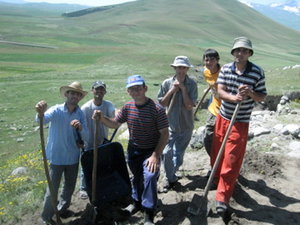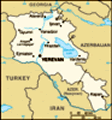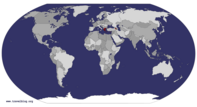Advertisement

 The T22/T27 Crew
The T22/T27 Crew
From left to right: Arman, Gennell, Vato, Aris, Arthurik and Arthur. It's amazing the sorts of complex discussions one can have with a very limited Armenian vocabulary and hand signals. We've discussed Turkish/Armenian relations, Barak Obama's presidency, World War II, what our parents do for a living, and what life might have been like 3000 years ago where we stood.Barev from Armenia! I arrived over a week ago, but I haven't been able to post to this blog due to technical difficulties. We were supposed to have wireless internet available in the dig house, but it turns out the the cheaper option was to get a wireless modem that attaches to the USB port of a computer and share that between all of us. The problem is, we can't get it to work on a number of computers. Anyway, I've figure out a system that should allow me to post once a week-- but it took a while to iron out the glitches. In any case, I'm glad that many of you appreciated last year's blog from Crete, and I'm happy to write again-- this time from Armenia. Please feel free to pass the blog info to anyone else who might be interested in following along-- and like last summer I'll try to post once a week, with pictures.
I arrived in Armenia last Wednesday, June 30th after my longest consistent travel so far. After leaving Newark Airport on Monday night and flying overnight to London Heathrow, I had a 12-hour layover there, and then flew overnight again from

 The Pickle (and Mt. Aragats)
The Pickle (and Mt. Aragats)
This small, green, climbing machine gets us up and down the hill each day. It's an old Soviet ambulance and is incredibly balanced. For the first few days I was sure we were going to roll off the hill, but sure enough, the "Pickle" (as we affectionately call it) keeps climbing, like the little engine that could. Mt. Aragats is visible in the background (in the clouds).London to Yerevan (the capital of Armenia) Tuesday night, arriving two days after I'd left. My time in London was well spent: I took the train to the city center and met my friend Katie, who is also working in Armenia with us, and had spent the past five days in London. We visited the British Library (akin to the Library of Congress) and saw some British national treasures, like a copy of the Magna Carta, Lewis Carroll's original manuscript of "Alice in Wonderland," and some of the envelopes, greeting cards and scraps of paper which the Beatles used to write some of their songs (like "She's Got a Ticket to Ride," and "Help!"). Afterwards, we headed to a local pub to have lunch and watch some of the World Cup, and eventually took the train back to Heathrow that night.
After flying through the night Tuesday, we arrived in Armenia around 7 AM Wednesday morning. On our final approach, we flew just to the east of Mt. Ararat, which is the tallest mountain in Turkey, and a serious point of contention between the Armenians and the Turks. It's a beautiful natural monument rising up above the surrounding plateau.

 T22
T22
The rock mess that is T22. There are at least three walls in this photo, can you pick them out? But, for the Armenians it is a constant reminder of the Ottoman Turk Empire and the Armenian genocide which occurred in the early 20th century. At one time Armenia claimed Ararat as its own, but after the genocide, and the ensuing border wars (largely associated with WWII), the Turkish/Armenian border was pushed further to the east and Ararat fell into Turkish hands. On the plane, an older Armenian diaspora couple(many Armenians have left the country due to its turbulent history during the 20th century), who were seated next to me (and from Toronto) pointed out to Ararat, and with a mixture of pride and sadness, said "Isn't she beautiful?" . A poignant beginning to my journey.
After sorting out a visa which will allow me to remain in country for 120 days (I'll only be here for about 50), Katie and I passed through immigration and customs without a problem and were picked up by Lori and an Armenian driver for our trip to Aparan, the smaller village we'll be staying in for the duration of the project. Lori and Adam are a husband and wife team, who run the excavations here, along with Ian, a third American colleague

 The Armenian National Museum
The Armenian National Museum
We'll be visiting the exhibits here over one of the off days during the season, but for now, the photo represents beautiful [Soviet] architecture. Who knew?and Ruben, their Armenian collaborator. Adam and Ruben began Project ArAGATS (The Project for the Archaeology and Geography of Ancient Transcaucasian Societies, and named after the highest mountain in Armenian, Mt. Aragats) eleven years ago, and they have done surface survey to pinpoint the location of ancient sites, test excavations at various Bronze Age and Persian period occupations, remote sensing work (similar to some of the work I've done on Cyprus) and are now thoroughly excavating two major sites, Tsaghkahovit and Gegharot. Both sites have Early and Late Bronze Age occupations levels, however Tsaghkahovit, which is the larger of the two, also has a very substantial Persian period occupation, and seems to be the citadel and headquarters used by the Persians to control the region. Adam, Ruben and Ian work on the Bronze Age aspect of the project, while Lori focuses on the Persian.
Last Thursday morning I visited Gegharot (where I'll be spending the next six weeks) for the first time. It's a small hill-top fortress, constructed mainly of stone, and which seems to have been surrounded by a lower town during the Late Bronze Age. "Constructed" is a loose term however, since today very little of the

 Republik Square
Republik Square
Like all good Soviet-era cities, Yerevan has a "Republik Square." Formerly the location of the Stalin, Lenin, etc. statues, now the square hosts the government buildings, national post office, and Marriot hotel.fortress still remains. The excavations are attempting to uncover both Early Bronze Age(3000-2200 BC) and Late Bronze Age (1600-1200 BC) occupation layers, but with different research questions. With regards to the Early Bronze Age levels, Project ArAGATS is concerned with trying to understand the various social, political and economic environment which led to (or allowed) the rise of "complex society." That is to say, we're trying to figure out the processes by which particular individuals were able to develop a social/political/economic power base that enabled them to command the labor and materials necessary to construct this fortress. For the Late Bronze Age occupations, we're interested in the extent of the fortress, and how it grew/changed from the Early Bronze Age. In Armenia (and the rest of the Caucasus, for that matter) there is a substantial archaeological hiatus during the Middle Bronze Age (2200-1600 BC), where our only real archaeological evidence is from kurgans (large tomb mounds), no one is sure, however, where the population was living. Hence, the return to complex, settled society during the early Late Bronze Age is also in question, as is the relationship between the citadel and the lower town-- that is, to use archaeology as a way of evaluating the relationship between the lord/chieftain/elite members of society and the "normal" people who lived in the town.
For the time being, I'm supervising the excavation of two trenches: a 5 m x 5 m trench located on the east side of the fortress, just inside the citadel wall which we began last Thursday (called T22), and a 5 m x 10 m trench just a meter to the north of T22 (T27). In 2008 (the last excavation season) a number of Late Bronze Age storage pits and architecture was found just upslope from T22, so we have been trying to better understand how the difficult stone walls that are emerging in my trench relate to one another, not just spatially but across time periods as well. With this goal in mind, we opened T27 in order to see if walls present in T22 continue to the north. Adam also thinks that this area of the site is one of the best candidates for the main administrative building, so he's expecting big things (no pressure, Jeff...), so cross your fingers. I have 6 Armenians working with me, all of whom speak very little or no English, and my Armenian consists of about thirty words (but is growing by five or ten words daily!), so we use a lot of hand gestures. So far, so good: we've found two beads, and a significant amount of pottery-- though we're still unclear as to how the architecture is laid out. In fact, just today, as I thought we were finally reaching the bedrock in T22, and I would be able to focus entirely on T27 going forward (I've been splitting my workers between trenches while I have both open), we came across a "sherd scatter" which is an archaeological way of saying, "a bunch of broken pots strewn across a dirt surface" ("sherds" refers to broken pieces of ceramics). In the long run, this will be useful since it will help us date the wall above this "sherd scatter" as occurring after the date of these ceramics, but it also means a lot of slow, tedious and extra work, since we need to excavate more carefully to leave the sherds in place for photographs, sweep the area around the sherds clean for photographs, take photographs, and all around be a bit more careful and deliberate with what we do. It was a total surprise for me (and for Ruben and Adam as well), and it will slow my crew down a bit, but it's important to document. I think our sentiment is best summed up by something Ruben said to me this afternoon: "Jeff, I learned a very important English phrase from a friend years ago, and it comes in very handy when dealing with archaeology: 'F---ing unbelievable."
Apart from excavations, we've experienced a bit of Armenia already, and we're promised to get a more thorough experience to come. Sunday night (for July 4th) we had a big party at a local restaurant, with local archaeologists and geologists attending as well. Apparently this July 4th party has become something of a tradition, and is eagerly awaited by many of the local archaeologists from year to year. The vodka was flowing (in great quantities) and we were treated to a local custom-- every time a new shot of vodka is poured for everyone at the table, someone must give a toast-- but not without asking the person who toasted prior for permission. And, these are not just any old toast, but long, thoughtful, and in many cases, very clever. I find the practice to be charming and endearing-- at first Adam and Ruben traded off toast for toast, but eventually other people joined in (having someone translate where necessary, as there were Russian, Armenian and English toasts). Despite the liquid courage that I consumed in a heavy dose, I still wasn't ready to try my hand at this toast-- though I certainly plan on giving at least one before I leave.
The following day (Monday) we had our day off, and visited Yerevan, the capital of Armenia. While we had driven through it on the way from the airport to the small town of Aparan (where we're staying), our second trip, minus the serious jet lag, was much more enjoyable. I was amazed at how beautiful and cosmopolitan it is. This is partially because the majority of the wealth in Armenia is located in Yerevan, and it is a stark contrast to Aparan, but I think it is also because I had a particularly bleak misconception about post-Soviet satellite states. As an American, I have always pictured the U.S.S.R. as a broken machine (which, in many cases it was), but the cosmopolitan nature of the city speaks to the Soviet ability to build beautiful architecture and wide promenade-type streets-- not the concrete ghettos that I was expecting. We'll visit Yerevan again, and the rest of the country on day trips during our days off over the next six weeks, but as of yet, Armenia has proven to be a beautiful country full of wonderful people.
More to come next week.
All the best, Jeff
Advertisement
Tot: 0.09s; Tpl: 0.013s; cc: 10; qc: 48; dbt: 0.0557s; 1; m:domysql w:travelblog (10.17.0.13); sld: 1;
; mem: 1.2mb









Maggie
non-member comment
Jeff's blog
Hey Jeff, great to hear about your trip so far.....I enjoy reading your stuff, it's informational, cleaver and descriptive (which I particularly appreciate). Anyway, have fun, looking forward to your next entry. Love, Aunt Maggie